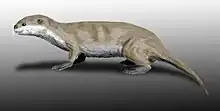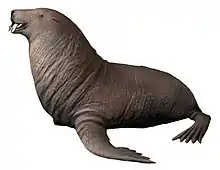| Prototaria Temporal range: Middle Miocene, | |
|---|---|
 | |
| Scientific classification | |
| Domain: | Eukaryota |
| Kingdom: | Animalia |
| Phylum: | Chordata |
| Class: | Mammalia |
| Order: | Carnivora |
| Clade: | Pinnipedia |
| Family: | Odobenidae |
| Genus: | †Prototaria Takeyama & Ozawa, 1984 |
| Type species | |
| †Prototaria primigena Takeyama & Ozawa, 1984 | |
| Other species | |
| |
Prototaria is an extinct genus of pinniped that lived approximately 15.97 to 13.65 mya[1] during the Middle Miocene in what is now Japan. It belonged to the family Odobenidae, the only extant species of which is the walrus. Members of the genus Prototaria are believed to be the most basal imagotariine pinnipeds.[2]
Unlike their closest living relative, the walrus, members of Prototaria were primarily piscivorous carnivores.
Description
Prototaria were more similar in appearance to modern fur seals and sea lions than walruses. They did not have long tusks as walruses do, and were more slender.
Fossils ascribed to Prototaria exhibit some autapomorphies, including: a large antorbital process and orbit, and a relatively narrow intertemporal region of the skull.[2] P. planicephala has a wider rostrum than P. primigena as well as more specialized cheek teeth and a flatter tympanic bulla.[3]
Taxonomy
The type species of Prototaria is P. primigena.[4] Based on skeletal traits and various autapomorphies, Naoki Kohno concluded that P. planicephala is more derived than P. primigena.[3]
References
- ↑ "†Prototaria Takeyama and Ozawa 1984 (walrus)". Fossilworks. Retrieved 17 December 2021.
- 1 2 Kohno, N.; Barnes, L.G.; Hirota, K. (December 1994). "Miocene fossil pinnipeds of the genera Prototaria and Neotherium (Carnivora; Otariidae; Imagotariinae) in the North Pacific Ocean: Evolution, relationships and distribution". Island Arc. 3 (4): 285–308. doi:10.1111/j.1440-1738.1994.tb00117.x.
- 1 2 Kohno, N. (1994). "A new Miocene pinniped in the genus Prototaria (Carnivora: Odobenidae) from the Moniwa Formation, Miyagi, Japan". Journal of Vertebrate Paleontology. 14 (3): 414–426. doi:10.1080/02724634.1994.10011568.
- ↑ Takeyama, K.; Ozawa, T. (1984). "A New Miocene Otarioid Seal from Japan". Proceedings of the Japan Academy. 60 (3): 36–39. doi:10.2183/pjab.60.36.



